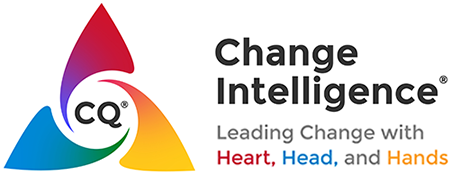The short answer is “yes.” Although in the U.S. women comprise half the workforce, earn the majority of college and post-graduate degrees, and own 40% of businesses, when we look at Fortune 500 companies, only 4% of CEOs and only 16% of Board Members are women. Yet, we also know from research by Catalyst, McKinsey, and others that a higher percentage of women in top leadership positions leads to 50% higher profitability, 25% increases in revenue, and higher motivation and retention rates.
What can we do about this paradox? Research into gender differences in leadership styles using the CQ/Change Intelligence Assessment reveals ideas for a new way forward.
Regardless of gender, each change agent has a basic tendency to lead with his or her Heart, Head, Hands, or some combination of the three. Leaders who lead mainly from the Heart connect with people emotionally (I want it!). Those who lead from the Head connect with people cognitively (I get it!). And those who lead from the Hands connect with people behaviorally (I can do it!). The powerful combination of all three is what Change Intelligence, or CQ, is all about.
My research clearly indicates that men tend to lead change more with the Head, women primarily with the Heart, and that for women, Hands is a strong secondary style:
Said another way, almost half of men surveyed lead change by focusing on vision, mission, and strategy (Head strengths). Almost half of women, conversely, place a premium on engaging, communicating, and collaborating (Heart strengths), and almost a third of women emphasize planning, tactics, and execution (Hands strengths). Most men have their radars tuned to purpose, and women on people and process.
Why is this? These findings are consistent with other research that shows women on the whole tend to display more emotionally intelligent as well as transformational leadership behaviors. Men focus on results, and women on relationships that facilitate results. Note that it is not inherently better or worse to focus on Heart or Head or Hands – the most effective change incorporates all three. The point is not for change leaders – men or women – to change their natural style. The point, instead, is awareness of our styles, and the ability to adapt our behavior to incorporate other approaches to be optimally impactful across a variety of people and situations. Also, the point is that when leading change, men tend to display behaviors traditionally associated with strategic executives, concentrating on future vision and new business horizons. Conversely, women tend to center on supporting their teams to work together and to detail a road map to achieve a change objective, functioning more like supportive coaches.
Implications? Many — both for men’s and women’s careers as leaders, as well as for organizations intent on leveraging the best leadership talent as well as on managing successful and sustainable change.
For organizations:
- What leadership behaviors do you value and promote during change processes? Are you including diverse perspectives –a focus on purpose and people and process? Managing change that sticks mandates a balance on all three.
- Are you including women in executive-level deliberations and decisions? Are they being mentored to develop their strategic business skills?
For women:
- Are you actively seeking opportunities to learn about other parts of the business, or are you “head down” in the trenches assisting your team and accomplishing your immediate objectives? At times, women need to get their heads up and out of their short-term and day-to-day responsibilities to develop Head skills!
- Is your voice being heard at work, beyond your immediate team? How can you expand your influence outside your work group and upward in your organization?
For men:
- Are you remembering to bring people along as you pursue your lofty goals (Heart skills)?
- Have you laid out a realistic plan and given people the training and the tools they need to partner with you on the journey (Hands skills)?
We need to remember that a significant percentage (over a third) of men do “start with the Heart” and a substantial number (over a quarter) of women do lead with the Head when facilitating change. A common complaint from both these groups is that they can be misunderstood, because at times their behaviors seem contrary to others’ expectations: men talking about exploring emotions and women about driving results. Change intelligent teams and organizations embrace all perspectives so people at all levels are empowered, engaged, and equipped to partner together to lead mission-critical transformation.

